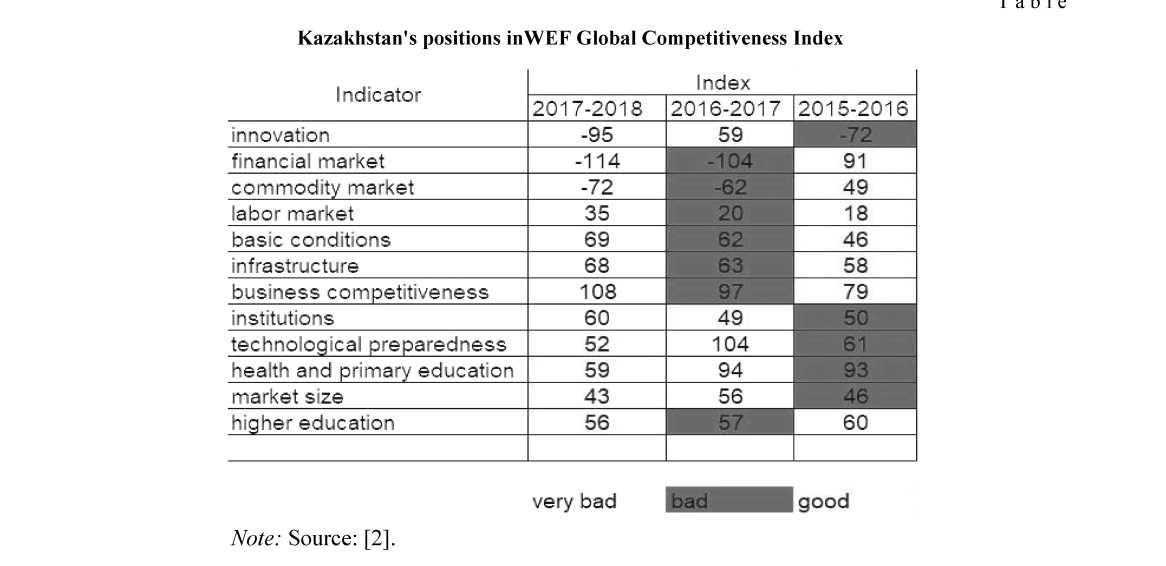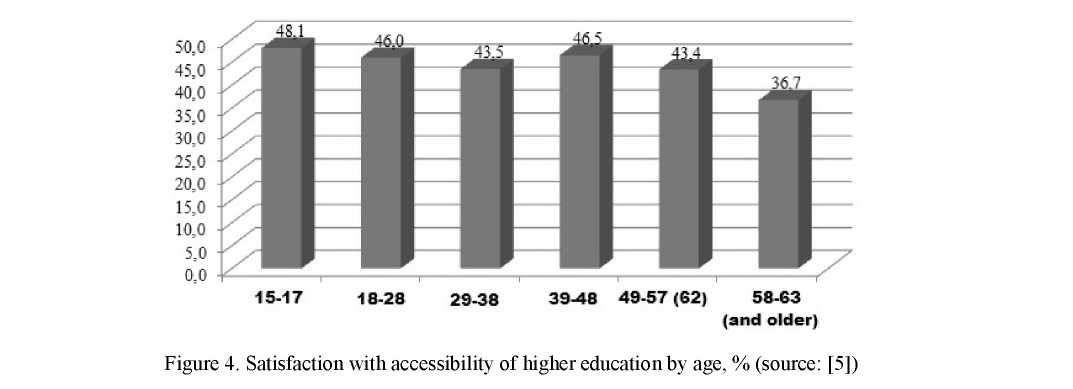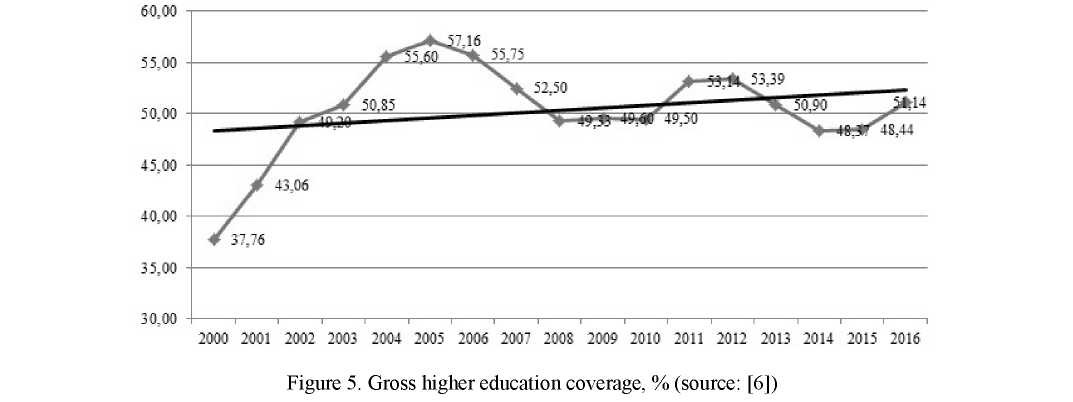Development of higher education ordinarily indicates the level of development of the country as a whole. This also refers to the accessibility of higher education, which is taken into account in the calculation of many world indexes that characterize the development of a particular state in the world ranking. The accessibility of higher education is one of the priorities for the development of higher education in Kazakhstan in accordance with the State Program for the Development of Education and Science for 2016-2019. The accessibility of higher education depends on many factors, including the standard of living of the population, tuition fees, financing of education by the state, the availability of various mechanisms for admission to higher education institutions. The article analyzes the accessibility of higher education in Kazakhstan, which results in drawing a conclusion that it is necessary to strengthen integration processes in the field of higher education aimed at improving the level of accessibility of education in higher education institutions of the country.
The level of development of higher education is known to indicate the level of development of the country as a whole. This is evidenced by the fact that world rating bodies include the level of development of higher education in their indexes of the country's competitiveness, human development, etc. in particular in the WEF Global Competitiveness Index of 2017-2018. The Republic of Kazakhstan ranks 57th in the list of 137 countries [1]. This index includes the availability of educational services, including higher education (Table 1).
In addition, the availability of higher education provides great opportunities for the young people, opening up prospects, including ones to improve material prosperity, which is a factor in the accessibility of the same higher education.
In this regard, the accessibility of higher education in Kazakhstan, which is designated as one of the main priorities of the State Program for Development of Education and Science for 2016-2019, is becoming a very significant problem.
It is known, that OECD in a succession of its reports for 2017 makes a recommends studying and, accordingly, increasing accessibility of higher education.
Despite the positive measures taken in the field of higher education, in Kazakhstan currently doesn't pay enough attention to equal access to higher education.In particular, as early as 2007, OECD developed and recommended a program of access to higher education for students from rural schools and low-income families, which provided flexibility in transfer from one major to another or from one university to another (for state grant holders) and encouraged university teachers to the teach school students, etc. [2]. However, when analyzing the education situation in 2017, the OECD group did not register any such programs or flexibility with regard to the change of a program. This means thatover 10 years there have been no significant changes in the sphere of higher education, especially with regard to the accessibility of higher education [Table].
In order to assess the accessibility of higher education in Kazakhstan, we will analyze a number of indicators reflecting this problem: the income level of the population, grant financing, the level of literacy of the population and the combinations of these factors.
As a rule, students from rural areas often have a lower level of preparedness for unified National Testing than the students living in cities. This is evidenced by the reviews of the Ministry of Education and Science of the Republic of Kazakhstan, National Center for Education Statistics and Assessment, OECD, World Bank, etc. Despite the fact that the state allocates 30 percent of the grant quota for rural graduates, distribution of state grants based on UNT results combined with lower quality of education in the regions creates an unfair barrier [3].
The difference in income levels of urban and rural population is added to this problem, which further exacerbates the inequality in accessibility of higher education (with regard to paid education services).
This indicator allows talking about a general decrease in the level of population satisfaction with the living standards. At the same time, in 2015 there was a sharp increase in this indicator in rural areas due to the adoption of state programs for agriculture development. However, in 2017, satisfaction started declining at a rapid pace (Fig. 1).
Of high importance in assessing the accessibility of higher education are grants, state orders, state loans, etc., and other alternative options for paying tuition (Fig. 2).
As can be seen in Figure 2, the reduction of student body in higher education institutions is accompanied by the reduction in the share of tuition paid from the state budget and from the population's own funds.At the same time, the tuition payment by the employers increases.On the one hand, this indicates that the accessibility of higher education is declining (since on average the share of payment at the expense of own funds remains practically at the same level), the share of payment from the state budget is decreasing. And, on the other hand, there is a positive trend of increase in the proportion of employers paying for training their future employees.Thus, companies make intellectual investments, contributing to the development of integration processes in universities (integration of business and education).


The problem of decrease in the standards of living of the population is exacerbated by an increase in tuition fees, making accessibility to higher education even lower. A survey of respondents in Kazakhstan regarding satisfaction with the cost of tuition fees in 2017 showed the following results: 21.6 percent of the urban population and 31.8 percent of the rural population are satisfied with higher education tuition fees (Fig. 3).
In broad terms, it can be noted that only half of the population is satisfied with the universities tuition fees based on their own financial situation. This is a low indicator that requires attention, since it is taken into account by many groups and agencies when calculating world ranking indices.
Regarding the satisfaction of the population of Kazakhstan with the accessibility of higher education, the results showed that only 43.3 % of the population wascompletely satisfied (Fig. 4).



Figure 4 shows that the population of 15 to 62 years olddemonstrate approximately the same results in terms of satisfaction with the availability of higher education in Kazakhstan. The indicators are quite low (less than half). As a reason why they consider higher education unavailable, they mostly note a low standard of living, high tuition fees, and a small number of state grants.
Thus, gross enrollment in higher education (taking into account vocational education) is quite low (Fig. 5).
The gross enrollment ratio in higher education is defined as the ratio of the number of students, regardless of age, studying in organizations of technical and vocational education and higher education institutions, to the total population aged 18-22. It should be noted that there is a tendency in the country foradult population (30-45 years) to get higher education when they already have the financial opportunity to pay their tuition.
Thus, at present there are a number of problems with regard to accessibility of higher education: low level of state funding, ineffective distribution of state financing, ineffective policy of student crediting, lack of interrelation between labor market needs and university graduates.
The OECD group notes that despite the apparent wide support of the state by awarding state grants, government subsidies continue to disproportionately support those who could learn without this support, being an irrational use of resources [7].
The lack of a mechanism to provide financial assistance from employers, based on paying tuition fee considering needs of the company in the relevant employee is an important obstacle to access to higher education in Kazakhstan. Students mostly pay for their education from personal funds and or from the state grants, while integration of business and education could significantly increase the accessibility of higher education and ensure the improvement of the quality of education based on the needs of the labor market.
Integration of higher education with previous and subsequent education stages could also expand access and address inequalities. If in schools we introduce, for example, a couple of subjects that are prerequisites for disciplines taught at the university, it would be possible to provide specialization, and, therefore, greater readiness and interest in entering universities.This kind of integration is very important and necessary in order to ensure at least a slight increase in the accessibility of higher education.
Integration of training programs between higher education institutions of different countries can also contribute to improving the accessibility of higher education. These programs should be of different levels, designed for heterogeneous categories of entrants, providing an opportunity to get higher education.
This kind of integration (with business and with curricula of foreign universities) will also contribute to improving the quality of education, since they will be focusedprimarily on developing practical skills that are in direct demand by employers themselves.
The interest of employers in the result of integration with higher education institutions, in qualified graduates possessing exactly those skills that are currently required at the labor market will also lead to an increase in the accessibility of higher education, since employers will be interested in paying for the training of their potential staff. This is an intellectual investment, which will pay back and will be a lot cheaper than continuous retraining of the staff that can transfer to another company.
142
Вестник Карагандинского университета

Thus, at present, the country's top leadership has recognized the problem of the low accessibility of higher education in the country and started a wide range of reforms. A new State Program for the Development of Education and Science for 2016-2019sets a national education strategy for the coming years [8].The priorities of the program also include improving the accessibility of higher educationthrough integration between education, science and industry, integrating Kazakhstan into the European Higher Education Area, encouraging employers to invest in training their potential employees, etc. In other words, the question is raised about creating an economic mechanism of integration processes in higher education both between the universities and within the universities.
References
- Kazakhstan vnov otstal ot konkurentov [Kazakhstan lagged behind its competitors again]. abctv.kz. Retrieved from http://abctv.kz/en/news/kazahstan-vnov-otstal-ot-konkurentov [in Russian].
- OECD / the World Bank (2007), Reviews of National Policies for Education: Higher Education in Kazakhstan 2007, OECD Publishing, Paris. dx.doi.org. Retrieved from http://dx.doi.org/10.1787/9789264033177-en.
- Natsionalnyi doklad o sostoianii i razvitii sistemy obrazovaniia Respubliki Kazakhstan (2016) [National report on the state and development of the educational system of the Republic of Kazakhstan]. Astana [in Russian].
- Uroven zhizni naseleniia [Standard of living of the population]. stat.gov.kz. Retrieved from http://stat.gov.kz [in Russian].
- Kachestvo zhizni naseleniia 2017 h. [Quality of life of the population in 2017]. stat.gov.kz. Retrieved from http://stat.gov.kz [in Russian].
- Obrazovanie [Education]. stat.gov.kz. Retrieved from http://stat.gov.kz [in Russian].
- OECD Multi-Dimensional Review of Kazakhstan 2016. oecd.org. Retrieved from http://www.oecd.org
- Hosudarstvennaia prohramma razvitiia obrazovaniia i nauki na 2016-2019 hh. [The State Program for the Development of Education and Science for 2016-2019]. Utverzhdena Ukazom Prezidenta RK ot 1 marta 2016 h. No. 205 - Approved by the Decree of the President of the Republic of Kazakhstan of 1 March 2016 No. 205. adilet.zan.kz. Retrieved from http://adilet.zan.kz [in Russian].